
|   |

|   |
 e-mail: sunilkothari1933@gmail.com Berlin Diary Photos courtesy: Rajyashree Ramesh November 13, 2016 Many years ago when along with Nayana Jhaveri, of the Manipuri exponents the Jhaveri Sisters, I was a joint secretary of Dancers'Guild in mid-sixties in Mumbai, I had received an invitation from Internationes, West German consulate to visit Germany to watch ballet classes and meet leading choreographers, dancers and critics. That was for the first time I had visited Germany, beginning with my stay in Munich. The first German word I had learnt for a street near railway station was Bahnhof strasse. It was quite an extensive visit taking me to Hamburg, Berlin, Frankfurt, and also I was able to visit East Germany, crossing Charlie check point and go to Leipzig, Dusseldorf and visit dance school of Palucca. That memory of my first visit to Berlin is still fresh as I had met leading ballet dancer and choreographer Richard Cragun at Berlin Opera House, where dancers were practicing ballet. I had taken lessons in photography with Subodh Chandra, my photographer friend, so I took several photos of ballet classes with help of Richard Cragun. I also met the diva ballerina Marcia Hydee, a legendary dancer. Berlin is a beautiful city and is full of history. Next to Paris, I love to visit Berlin. After that first visit, I did go many times to Berlin from London. From 1968 till 1980 I regularly visited London, and it was then easy to travel by train to other destinations in Europe. I used to write for The Times of India as a dance critic and my several dispatches on dance in Europe were published in Sunday Times. Those two decades of travels in Europe and USA gave me exposure to Western ballet, Modern and Contemporary dance forms, and I met leading choreographers, ballet dancers and critics. The advantage of meeting bureaucrats in those years was, a friendship was built up, and we kept in touch. At that time there were not many dance critics from India travelling in Europe and writing on Western dance forms. A letter from the Editor of The Times of India, requesting institutions to give press facilities to their dance critic, opened up many doors of ballet companies to me. The bureaucrats in charge of culture in our missions abroad were taking interest in classical dance and music. And my illustrated talks on dance with demonstration of the dance form by Indian Diaspora dancers in the city helped the mission to engage local Indian Diaspora community and artists to take active part in activities organized by the mission. 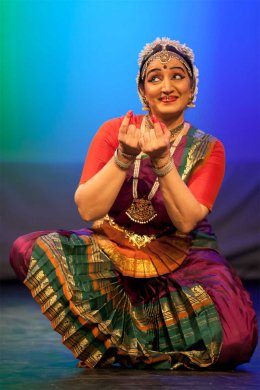 Rajyashree Ramesh
During one of my visits to Frankfurt for World Dance Alliance Asia Pacific Organization, I had met Rajyashree Ramesh, a Bharatanatyam dancer from Bangalore, settled in Berlin. At that time diplomat Mr. Malay Mishra was in Berlin. He had come across my articles on dance, in particular, on Odissi and had found them interesting. Being an Odiya, his interest was naturally in revival of Odissi, but he also appreciated other forms like Kathak and Bharatanatyam. During my visit to Berlin, he invited me to an evening of classical dance performances. From Essen, Birju Maharaj's disciple Durga Arya had come to perform Kathak and Rajyashree was to perform Bharatanatyam. Both of them are versatile dancers in their chosen idioms. On that evening, however Durga Arya was in great form and overshadowed Bharatanatyam with breathtaking chakkars, pirouettes, and footwork. I had known Durga Arya in Delhi performing Kathak under supervision of Birju Maharaj and she is an excellent Kathak dancer. Even when she migrated to Essen, Kathak biradari, community, remembers her well for her outstanding quality of Kathak. Rajyashree was a little upset for scheduling Kathak earlier than Bharatanatyam. I had explained to her that there was no reason to be upset or feel that Bharatanatyam in comparison with Kathak lacks something. It depends upon the mood of the audience also who gets carried away with chakkars and jugalbandi with percussionist and its popular appeal. Bharatanatyam has its own impeccable structure and gradual build up from pure dance to abhinaya and with varnam, it gains momentum followed by leisurely pace of padams, javalis and then quick paced tillana etc. Our dialogue started. I was keen to learn more about her migrating to Berlin and teaching Bharatanatyam against all odds to German dancers. We corresponded and kept in touch over the years. Ten years ago, Indian Embassy and her institution Rajyashree Ramesh Academy of Performing Arts had arranged my illustrated talk on New Directions in Indian Dance in Berlin, but as ill luck would have it, before leaving for Berlin, a day in advance, my laptop, passport, money etc were stolen in London, near a railway metro station, and my visit to Berlin had to be cancelled, as even when Indian High Commissioner issued me the passport on Friday, the visa for Germany could not be given on Saturday and on Sunday my lecture was scheduled, which, alas, had to be cancelled. I once attended the debut performance of Ellen Winkler, her German dancer in Bangalore. It was indeed commendable to see her German disciple perform well. Rajyashree was also studying Laban Notation and was devising a methodology to use it in a manner that would help her German disciples to master Bharatanatyam movements easily. In collaboration with The Tagore Centre in Berlin which is headed by Manjishtha Mukherjee Dutta, Rajyashree worked out a proposal to present excerpts of her choreography of Tagore's songs and my illustrated talk with excerpts of dances of Uday Shankar, Ram Gopal and Mrinalini Sarabhai, interweaving with screening, live performances and ending with "Natanam Adinar" in Bharatanatyam with her eight German dancers. Since Manjishtha Mukherjee knew me from Mumbai and also we had last met in Beijing in 2011, for year of Festival of India in China curated by my friend and renowned director Ratan Thiyam, she readily agreed to schedule my lecture with the screening and Rajyashree's and her disciples' presentation. Besides, Rajyashree arranged workshops for her German disciples for one whole day which was quite a challenge for me. I readily agreed to work out choreographic patterns in nritta and improvisations in abhinaya.  Performance at embassy
The new building of Indian Embassy in Berlin is a beautiful one, designed by a well known architect and quite imposing. The Tagore Centre in Embassy has a well equipped auditorium for 200 hundred people to sit comfortably. Majority of performances, lectures, seminars are held there. The technical assistant arranged screening in a flawless manner with super German efficiency. The presentation of excerpts of Tagore's song from Chitrangada by Rajyashree, and group choreography of "Ekla chalo re" by four dancers was performed smoothly with live music and accompaniment of a pair of tablas by Laura Patchen, disciple of Pandit Kamalesh Maitra, and to melodious music rendered by Sankalita Mandal, a young Bengali student doing her Ph.D, evoking the mood of Rabindra Sangeet. The audience consisting of Germans had not seen Uday Shankar's performances, nor of Ram Gopal or Mrinalini Sarabhai and the talk and screenings were well received. Of course, the "Natanam Adinar" as group dance edited and choreographed by Rajyashree and her disciples received enthusiastic ovation. We were privileged to have in audience the celebrated mime artist Irshad Panjatan who has settled in Berlin and scholars and professors from the University. A few common friends including Mini Kapoor, who runs a gallery titled Under a Mango Tree, and is a friend of photographer Avinash Pasricha, attended the program. Not having ever seen Uday Shankar, Mini Kapoor wanted to have second evening for young generation of dancers. Seasoned Indian stalwart Sankajith Guha, who has been arranging performances of visiting Indian dancers, was delighted to see this unusual program. Manjishtha was very happy at the turn out of the audience, as Tagore Centre had for the month of June several events in succession. Enthusiastic and dynamic, she has won great popularity among Indian Diaspora and Germans for arranging a series of events which keep Tagore Centre busy round the year. One of the students of Rajyashree had known me from my workshop in Ghent, where for Jetty Roels of World Dance Alliance Asia Pacific had arranged a workshop for her Bharatanatyam students. Impersonating different characters the eight dancers enjoyed improvising once the story line was explained. In the afternoon session we took up the pure dance patterns. Selecting one of the talas, we asked them to form triangles, squares, centrifugal and centripetal circles and combine imaginative patterns. It generated quite an excitement and few of them came up with novel ideas. I was very happy to see the enthusiasm on their part and regularly attending the classes held at two / three venues. Over the past 30 years, Rajyashree has built up a formidable reputation as a strict teacher for sound training. Beyond Berlin in Germany she has opened branches in Vilinius, Lithuania. Some of those dancers from Lithuania, whose performances I saw on DVD, were impressive. Rajyashree told me that she finds it extremely difficult to get German bodies to lose their stiffness, whereas dancers from Lithuania grasp the movements easily and bring the appropriate grace to their performances. 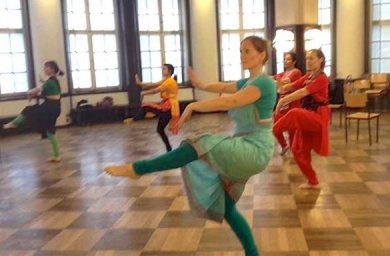
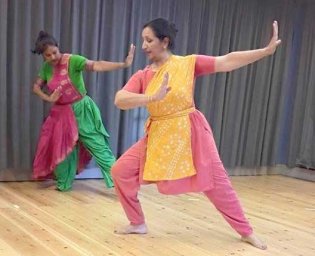
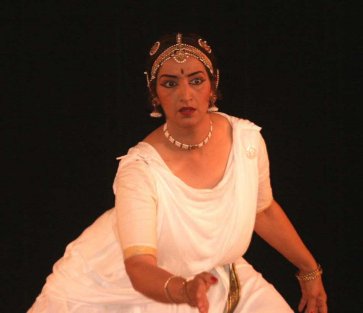
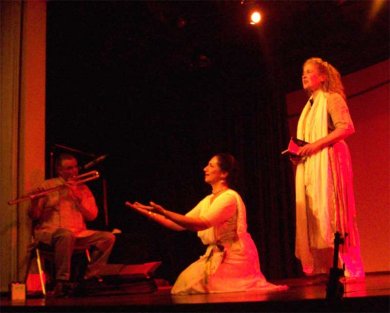
Iphigenie
Born in Pune and brought up in Mumbai and Bangalore, Rajyashree was trained in classical music from a very young age. She also took lessons in Bharatanatyam and Kuchipudi and completed Karanataka State Dance and Music Examinations. She sought further training visiting Chennai and studying Kuchipudi under Vempati Chinna Satyam, abhinaya under Kalanidhi Narayanan and Bharatanatyam under Savitri Jagannath Rao. She is living in Berlin since 1977. She has done pioneering work winning laurels for Indian classical dance by training German and few Indian Diaspora dancers settled in Berlin. She has been transmitting and translating the Indian dance vocabulary to varied target groups at cultural and educational institutions through performances, teaching assignments, workshops, lectures, outreach programmes and writing articles both in German and English. Several leading dancers from India, including Alarmel Valli, Chitra Visweswaran, Dr Francis Barboza, Padmini Ravi, Savitri Jagannath Rao, and Dr. Vasundhara Doreswamy have given workshops during their visits to Berlin at her academy. In 1995, Rajyashree founded the dance ensemble Rasika to provide platform for dancers trained in Germany. Now it has grown into Rasika Dance Theatre International, promoting classical-innovative approach to Indian dance and has encouraged cross-cultural artistic work with international artists of various genres. Not content with training the German dancers in Bharatanatyam, Rajyashree has choreographed creative and innovative works with German artists. Among them, with actor Erika Eller she premiered Goethe's Iphigenie in 1997. Dance Immemorial, a multi-national dance production in 2003, Das Ramayana-Epos, a special production for State Theatre Chemnitz in 2004/5, Jalakrida- the water play, a production which concerns water in 2005, Korpersprachen-Mundarten, a cultural cross-over with international artists in 2007, Seoul Moves, a multimedia art and identity project for Sogang University, Seoul, Korea in 2009, and in 2012 The Cosmic Body, a research based solo drawing from ancient yogic and dance concepts and modern movement studies. There are other productions under the pipeline. Her major concern is with teaching. Trans-cultural performance interests her. She visited USA to study integrated movement studies for a Certified Laban Movement Analyst course. For the past decade she has been channelling her intercultural professional knowledge and experience into academic research. Her doctoral thesis under Prof Dr. Comellia Muller focuses on placing the inherent embodied knowledge in dance into a cross disciplinary scientific framework. Rajyashree has published her scholarly papers both in German and English. A Grammar of Gestures in Indian Dance and Dance Theatre, and Gestures in Southwest India: Dance, have been published in prestigious International Hand Book on Body- Language –Communication in Vol I and Vol II. Other articles like Krishna zeig Dein Gesicht, Abhinaya: Erzahlkunst Im Indischen Tanz are included in various anthologies in German language. A special issue of Shanmukha journal of Shanmukhananda Fine Arts Society, Mumbai, has carried her article on teaching Bharatanatyam in foreign countries. Though I had met Rajyashree and known her, this was the first time that I met her supportive husband Ramesh who is an engineer. They have a daughter Kirthi Ramesh, who has studied dance under Rajyashree and moved to Philippines, where she has a studio and continues to practice dance along with her job. Son Kiran is studying sound engineering and is interested in music. Rajyashree loves to teach and is anxious to complete her Ph.D as early as she can. 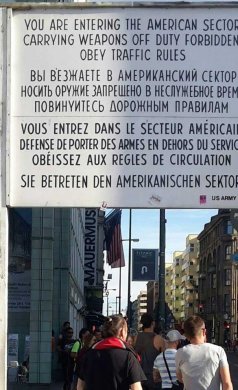
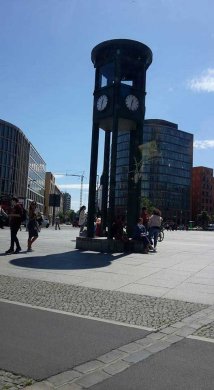
Besides the performances, lecture and screening of films and workshops, we found time to visit Berlin's most well known historic monuments. The city was caught up in football fever, and near the ground at the most famous monument Brandenburg Gate, large screens were mounted for crowds to watch the football game. I visited the Berliner Ensemble theatre and saw the statue of Brecht. Years ago I had seen Mother Courage there. We visited Charlie Checkpoint and saw the part of Berlin Wall which is no more except some parts and marks on the road. The warning at the American Centre at Charlie Checkpoint reads as follows: "You are entering the American sector, carrying weapons off duty is forbidden. Obey traffic rules." We saw the famous German car Trabi there in all colourful designs. There were landmarks with signage The Berlin Wall and a museum in bold letters 'The Berlin Wall See it here.' There is an open museum of period of terrorism and several photographs, giving historical account of Hitler's regime. I had in earlier visits, visited the places where Jews were tortured. Therefore I did not want to go through those horrible accounts of mass killings. The old tower with clock of East Berlin is specially brought and preserved. The row of bricks on the floor was of former wall now demolished. We spent one evening in the Museum district. The most popular place near Bodo Museum is where the action is. Young people congregate for fun, frolic and dance. The Island of Museum is a conglomeration of various museums. Under the Mango Tree is a gallery which Mini Kapoor runs. Earlier we visited it and saw paintings by German painters. Rajyashree and Mini Kapoor had planned a special program of improvisation titled 'The Simple and the Complex: Dance meets visual arts' to the music by Rambha Janardhan's saxophone and mandolin. Near each painting by Joris Goritz Allusion, Rajyashree would spontaneously perform. She was not allowed to see the exhibition in advance. On the day of performance only she would see and move from painting to painting and perform movements that would approximate the visuals. The visit to Free University was a must. Bharatanatyam and contemporary dancer Navtej Singh is currently working on Abhinavagupta there. Rustom Bharucha regularly conducts seminars. It has a very rich library. The various buildings including one of the scientist, who invented Atomic Bomb is nearby. A week was not enough for me to savour the beauty and academic character of the city. I hope to visit it again.  Dr. Sunil Kothari is a dance historian, scholar, author and critic. He is honored with Padma Shri, Sangeet Natak Akademi award and Senior Critic Award from Dance Critics Association, NYC. Post your comments Please provide your name and email id when you use the Anonymous profile in the blog to post a comment. All appropriate comments posted with name & email id in the blog will also be featured in the site. |